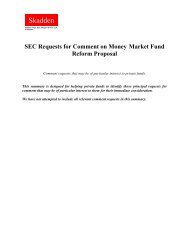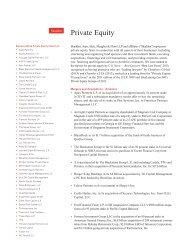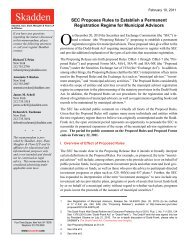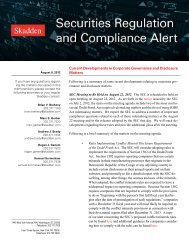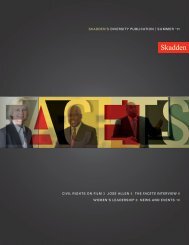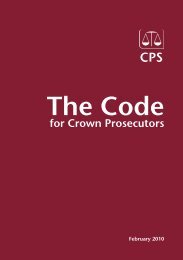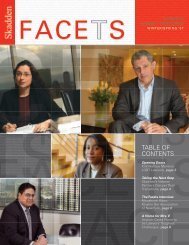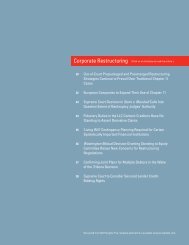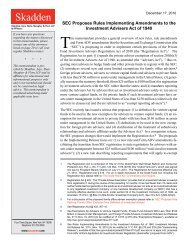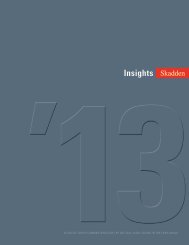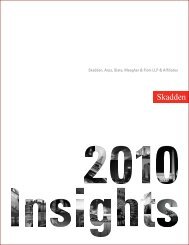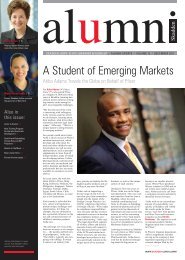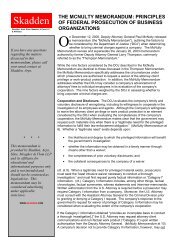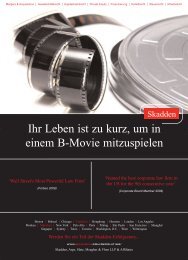Here - Skadden
Here - Skadden
Here - Skadden
You also want an ePaper? Increase the reach of your titles
YUMPU automatically turns print PDFs into web optimized ePapers that Google loves.
Case 1:10-cv-00745-PKC Document 32 Filed 11/29/10 Page 5 of 22<br />
items ofwhich judicial notice may be taken. See Samuels v. Air Transp. Local 504,992 F.2d 12, 15<br />
(2d Cir. 1993). With respect to the latter, the court may take judicial notice of"public records and of<br />
admissions in pleadings and other documents in the public record filed by a party in other judicial<br />
proceedings that contradict the party's factual assertions in a subsequent action." Munno v. Town of<br />
Orangetown, 391 F.Supp.2d 263,268-69 (S.D.N.Y. 2005) (internal quotation marks omitted) (taking<br />
judicial notice of affidavits and pleadings submitted by plaintiff and letters written by plaintiffs<br />
counsel in a prior state court action that allegedly contradicted plaintiffs allegations in the present<br />
matter). To the extent that such documents bear on the issues in this action and not for the truth of<br />
their content the court takes judicial notice of the pleadings filed by the Commission against the<br />
Promoters in S.E.C. v. Reynolds, 3:08 Civ. 0438-G (N.D. Tex.) (filed Mar. 13,2008) and S.E.C. v.<br />
Feeback, 3:10 Civ. 00104-K (N.D. Tex.) (filed Jan. 20, 2010).<br />
In addition to the pleading requirements of Rule 12(b)(6), a complaint alleging<br />
securities fraud must satisfy the heightened pleading requirements ofRule 9(b), Fed. R. Civ. p.l<br />
Rule 9(b) requires that a party alleging fraud "state with particularity the circumstances constituting<br />
fraud." Requiring particularity serves to give a defendant notice ofthe plaintiffs claim and<br />
safeguards a defendant's reputation from "improvident" charges. See ATSI Comm., Inc. v. Shaar<br />
Fund, Ltd., 493 F.3d 87,99 (2d Cir. 2007). To satisfy this pleading threshold, the complaint must<br />
'''(1) specify the statements that the plaintiff contends were fraudulent, (2) identify the speaker, (3)<br />
state where and when the statements were made, and (4) explain why the statements were<br />
fraudulent.'" Novak v. Kasaks, 216 F.3d 300,306 (2d Cir. 2000) (quoting Shields v. Citytrust<br />
Bancorp, Inc., 25 F.3d 1124, 1128 (2d Cir. 1994)).<br />
I The heightened pleading requirements set forth in the Private Securities Litigation Reform Act ("PSLRA") do not<br />
apply to actions filed by the Commission. 15 U.S.c. § 78u-4(a)( I) ("The provisions of this subsection shall apply in<br />
each private action arising under this chapter."); see In re Reserve Fund Sec. & Derivative Litig., 09 Md. 2011<br />
(PGG) 09 Civ. 4346 (PGG) - F.Supp.2d 2010 WL 685013, *6 (S.D.N.Y. Feb. 24,2010) (finding that the terms of<br />
the PSLRA do not apply to fraud actions tiled by the Commission).<br />
5
Case 1:10-cv-00745-PKC Document 32 Filed 11/29/10 Page 6 of 22<br />
II. Commission's Claims Pursuant to Section lOCb), Rule lOb-5 and Section l7(a)<br />
In order to state a claim under section 10(b) of the 1934 Act, 15 U.S.C. § 78j(b), and<br />
Rule lOb-5 promulgated thereunder, 17 C.F.R. § 240.10b-5, the SEC must plead that the defendant<br />
H(1) made a material misrepresentation or a material omission as to which he had a duty to speak, or<br />
used a fraudulent device; (2) with scienter; (3) in connection with the purchase or sale of securities."<br />
S.E.C v. Monarch Funding Corp., 192 F.3d 295, 308 (2d Cir.1999).<br />
The same elements required to establish a section 1 O(b) and a Rule 10b-5 violation<br />
suffice to establish a violation under sections 17(a)(I) - (3), with the exception that scienter is not<br />
required for the Commission to enjoin violations under subsections (a)(2) or (a)(3). See Id. 2<br />
Moreover, contrary to the defendant's argument that section l7(a) requires that the defendant be an<br />
actual seller or offeror of securities for liability to attach, section 17( a) establishes broad anti-fraud<br />
prohibitions that are not limited to actual sellers of securities and can apply to persons "who neither<br />
passed title nor solicited offers on behalf of securities issuers or sellers." S.E.C. v. Badian, 06 Civ.<br />
2621 (LTS) (DFE), 2008 WL 3914872, *6 (S.D.N.Y. Aug. 22,2008) (rejecting defendants'<br />
argument that section 17 ( a), similar to section 12 of the Securities and Exchange Act of 1 934,<br />
incorporates a "statutory seller" requirement). First, the statutory language of section l7(a), which<br />
bars "any person in the offer of sale of any securities ... directly or indirectly ... to employ any<br />
device, scheme or artifice to defraud ...." 15 U.S.C. § 77q(a)(1), is broad and does not impose a<br />
2 Section 17(a) provides in relevant part:<br />
It shall be unlawful for any person in the offer or sale of any securities ... by the<br />
use of any means or instruments of transportation or communication in interstate<br />
commerce or by the use of the mails, directly or indirectly (1) to employ any<br />
device, scheme, or artifice to defraud; (2) to obtain money or property by means<br />
of any untrue statement ofa material fact or any omission to state a material fact<br />
necessary in order to make the statements made, in light of the circumstances<br />
under which they were made, not misleading; or (3) to engage in any<br />
transaction, practice, or course of business which operates or would operate as a<br />
fraud or deceit upon the purchaser."<br />
15 U.S.c. § 77q(a).<br />
6
Case 1:10-cv-00745-PKC Document 32 Filed 11/29/10 Page 8 of 22<br />
intended to be "define[ dJ broadly" and is "expansive enough to encompass the entire selling process,<br />
including the seller/agent transaction." Id. at 773. "The language does not require that the fraud<br />
occur in any particular phase of the selling transaction .... Thus, nothing in subsection (1) or § l7(a)<br />
creates a requirement that injury occur to a purchaser." Id.<br />
Additionally, focusing on the statutory purpose, the Court highlighted that "neither<br />
this Court nor Congress has ever suggested that investor protection was the sole purpose of the<br />
Securities Act." Id. at 775. "Prevention of frauds against investors was surely a key part of that<br />
program, but so was the effort to achieve a high standard ofbusiness ethics ... in eve!)' facet ofthe<br />
securities industry." Id. (internal quotation marks omitted) (emphasis in original). Specifically, the<br />
Court emphasized that "the welfare of investors and financial intennediaries are inextricably linked<br />
- frauds perpetrated upon either business or investors can redound to the detriment ofthe other and<br />
to the economy as a whole." Id. at 776.<br />
Similarly, the fraud need not have been perpetrated on an actual or potential investor<br />
to constitute a violation of section 1O(b) and Rule 10b-5. Even though the Court in Naftalin<br />
addressed section 17(a)(1), the statutory language there "in the offer or sale of any securities" IS<br />
virtually identical to the language in section 1 O(b) of the Securities Exchange Act - "in connection<br />
with the purchase or sale of any security." Compare 15 U.S.c. § 77q(a)(1) with 15 US.c. § 78j(b).<br />
In Naftalin, the Court noted that the tenns "in" and "in connection with" have on occasion been used<br />
interchangeably. 441 U.S. at 773 n.4. Moreover, the broader language of section 1 O(b) cannot be<br />
read to require that the fraud occur in any particular phases of the selling transaction. See Graham v.<br />
S.E.C., 222 F.3d 994, 1002-03 (D.C. Cir. 2000) (holding that the Supreme Court's unanimous<br />
decision in N aftalin forecloses petitioner's argument that to constitute a violation of section 1 O(b) the<br />
fraud must have been perpetrated upon an actual or potential investor); see also A.T. Brod & Co. v.<br />
8
Perlow, 375 F.2d 393, 396 (2d Cir. 1967) ("Neither § lOeb) nor Rule 10b-5, it appears, speaks in<br />
tenus oflimiting the nature ofthe violation to one involving fraud of 'investors'; nor is there any<br />
justification for reading such an additional requirement into the Act. These rules and regulations<br />
were ... designed to protect both investors and 'the public interest. ''').<br />
Moreover, the Supreme Court has "espoused a broad interpretation" ofthe phrase "in<br />
connection with" in the context of section lOeb) and Rule IOb-5. Merrill Lynch, Pierce, Fenner &<br />
Smith Inc. v. Dabit, 547 U.S. 71, 85 (2006). "Under our precedents, it is enough that the fraud<br />
alleged 'coincide' with a securities transaction - whether by the plaintiff or by someone else." Id.<br />
(citing United States v. O'Hagan, 521 U.S. 642,651,659 (1997) ("[Section lOb] requires deception<br />
'in connection with the purchase or sale of any security,' not deception of an identifiable purchaser<br />
or seller.") and S.E.C. v. Zandford, 535 U.S. 813, 819-20, 822 (2002) ("[Section lOb and Rule lOb<br />
5] should be construed not technically and restrictively, but flexibly to effectuate its remedial<br />
purposes.") (internal quotation marks omitted»).<br />
B. Materiality<br />
"At the pleading stage, a plaintiff satisfies the materiality requirement ofRule lOb-5<br />
by alleging a statement or omission that a reasonable investor would have considered significant in<br />
making investment decisions." Ganino v. Citizens Utils. Co., 228 F.3d 154, 161 (2d Cir. 2000)<br />
(citing Basic Inc. v. Levinson, 485 U.S. 224,231 (1988) (adopting the standard in TSC Indus., Inc.<br />
v. Northway, Inc., 426 U.S. 438,449 (1976), for section lOeb) and Rule 10b-5 actions». Whether an<br />
alleged misrepresentation or omission is material depends on all the relevant circumstances ofthe<br />
case. Id.<br />
Case 1:10-cv-00745-PKC Document 32 Filed 11/29/10 Page 9 of 22<br />
Materiality is a "mixed question of law and fact, involving as it does the application<br />
of a legal standard to a particular set of facts." TSC Indus. v. Northway, Inc., 426 U.S. 438, 450<br />
9
Case 1:10-cv-00745-PKC Document 32 Filed 11/29/10 Page 10 of 22<br />
(1976). On a Rule 12(b)(6) motion to dismiss, '''a complaint may not properly be dismissed ... on<br />
the ground that the alleged misstatements or omissions are not material unless they are so obviously<br />
unimportant to a reasonable investor that reasonable minds could not differ on the question of their<br />
importance.'" Ganino, 228 F.3d at 162 (alteration in original) (quoting Goldman v. Belden, 754 F.2d<br />
1059, 1067 (2d Cir.l985).<br />
The defendant argues that the alleged misstatements are not material to a reasonable<br />
investor because they were contained in documents maintained exclusively in the files of the Issuers'<br />
transfer agents and were not disseminated to the public. The fact that the alleged misrepresentations<br />
were made to the transfer agent rather than to the public, however, does not foreclose their being<br />
material. See Naftalin, 441 U.S. at 776 ("The welfare of investors and financial intermediaries are<br />
inextricably linked frauds perpetrated upon either business or investors can redound to the<br />
detriment of the other and to the economy as a whole.").<br />
A misstatement made in any phase of the selling transaction can be material if a<br />
reasonable investor would have considered the defendant's alleged misrepresentations important,<br />
even if the statement is not made directly to the investor. Investor reliance is not a necessary<br />
predicate for a finding of materiality. 3 <strong>Here</strong>, reasonable minds could differ on the question of<br />
whether the defendant's misrepresentations to the Issuers' transfer agents were important to a<br />
reasonable investor. Undoubtedly, a reasonable investor could consider Czarnik's statements<br />
regarding the validity of issuing unrestricted shares to be important information. A transfer agent<br />
seeks to have an attorney submit an opinion letter as to the legality of issuing unrestricted stock and<br />
other supporting documents to legitimize the agent's issuance of the unrestricted stock. Insofar as<br />
the attorney's opinion letter and other documents necessarily inform the transfer agent's decision,<br />
3 Additionally, unlike a private plaintiff, the Commission does not need to plead or prove reliance.<br />
Credit Bancorp, Ltd., 195 F.Supp. 2d 475,490-91 (S.D.N.Y. 2002).<br />
10
Case 1:10-cv-00745-PKC Document 32 Filed 11/29/10 Page 11 of 22<br />
misrepresentations in such documents may be considered important by the reasonable investor.<br />
C. Scienter<br />
As set forth above, in order to state a claim under section 1 O(b), Rule 1 Ob-5 and<br />
section 17(a)(I), a complaint must allege that the defendant acted with scienter. To adequately plead<br />
scienter in the context of securities fraud, a plaintiff must "allege facts that give rise to a strong<br />
inference of fraudulent intent." Novak, 216 F3d at 306 (quoting Acito v. IMCERA Grp., Inc., 47<br />
F3d 47,52 (2d Cir. 1995). A "strong inference" of fraudulent intent "may be established either (a)<br />
by alleging facts to show that defendants had both motive and opportunity to commit fraud, or (b) by<br />
alleging facts that constitute strong circumstantial evidence ofconscious misbehavior or<br />
recklessness." Novak, 216 F.3d at 307 (internal quotation marks omitted).4 <strong>Here</strong>, the Commission<br />
asserts that they have adequately pled scienter by alleging facts that constitute strong circumstantial<br />
evidence ofdefendant's conscious or reckless misconduct. (PI. Opp'n. to Def. Mot. to Dismiss 4.)<br />
Reckless conduct is '''at the least, conduct which is highly unreasonable and which<br />
represents an extreme departure from the standards of ordinary care ... to the extent that danger was<br />
either known to the defendant or so obvious that the defendant must have been aware ofit. '" Novak,<br />
216 F3d at 308 (ellipsis in original) (quoting Rolfv. Blyth, Eastman Dillon & Co., Inc., 570 F.2d<br />
38,47 (2d Cir. 1978) (internal quotation marks omitted». The Second Circuit in Novak provided<br />
4 The Second Circuit's "strong inference" standard predated the adoption of the PSLRA and, indeed, has been<br />
incorporated into the PSLRA. 15 U.S. C. § 78u-4(b )(2) (requiring plaintiff to "state with particularity facts giving<br />
rise to a strong inference that the defendant acted with the required state of mind. "); see Novak, 216 F.3d at 311<br />
("[W]e hold that the PSLRA adopted our "strong inference' standard ...."). There is nothing to suggest, however,<br />
that the "strong inference" standard as used in the PSLRA governs actions brought by the Commission. See In re<br />
Reserve Fund Sec., 2010 WL 685013 at *6 (finding that the terms of the PSLRA do not apply to fraud actions filed<br />
by the Commission). The Supreme Court in Tellabs. Inc. v. Makor Issues & Rights. Ltd., clarified that the "strong<br />
inference" required under the PSLRA exists only where "a reasonable person would deem the inference of scienter<br />
cogent and at least as compelling as any opposing inference one could draw from the facts alleged." 551 U.S. 308,<br />
310 (2007). Although the Second Circuit has not directly addressed the issue, courts in this Circuit have declined to<br />
extend the Supreme Court's interpretation of the PSLRA's "strong inference" standard in Jellabs to Commission<br />
enforcement actions. !Uk, In re Reserve Fund Sec., 2010 WL 685013 at *6; S.E.C. v. Pentagon Capital Mgmt,<br />
PLC, 612 F.Supp.2d 241, 263-64 (S.D.N.Y. 2009); SEC. v. Dunn, 587 F.Supp.2d 486,501 (S.D.N.Y. 2008).<br />
Similarly. this Court adopts this approach.<br />
11
the following guidance as to the types of facts sufficing to state a claim based on recklessness:<br />
"[T]ypically [complaints] have sufficed to state a claim based on recklessness when they have<br />
specifically alleged defendants' knowledge of facts or access to infonnation contradicting their<br />
public statements." 216 F.3d at 308. Moreover, allegations of recklessness have been found to be<br />
sufficient where "plaintiffs alleged facts demonstrating that defendants failed to review or check<br />
infonnation that they had a duty to monitor, or ignored obvious signs of fraud. Id. '''An egregious<br />
refusal to see the obvious, or to investigate the doubtful, may in some cases give rise to an inference<br />
of ... recklessness.'" Id. (ellipsis in original) (quoting Chill v. Gen. Elec. Co., 101 F.3d 263,269<br />
(2d Cir. 1996)).<br />
Novak also identified several important limitations on the scope of allegations<br />
sufficient to state a claim based on recklessness. First, allegations of "fraud by hindsight" are not<br />
sufficient. Id. at 309. ("[Defendants] need not be clairvoyant; they are only responsible for<br />
revealing those material facts reasonably available to them."); Denny v. Barber, 576 F.2d 465,<br />
470 (2d Cir. 1978). Second, "conclusory allegations - that Defendants 'knew but concealed' some<br />
things, or 'knew or were reckless in knowing' other things - do not satisfy the requirements ofRule<br />
9(b).... [S]uch allegations are 'so broad and conclusory as to be meaningless.'" Shields v. Citytrust<br />
Bancorp, Inc., 25 F.3d 1124, 1129 (2d Cir. 1994) (quoting Decker v. Massey-Ferguson, Ltd., 681<br />
F.2d 111, 120 (2d Cir. 1982)). "Where plaintiffs contend defendants had access to contrary facts,<br />
they must specifically identify the reports or statements containing this infonnation." ;N"ovak, 216<br />
F.3d at 309.<br />
Case 1:10-cv-00745-PKC Document 32 Filed 11/29/10 Page 12 of 22<br />
1. Allegations of Scienter in Connection with MVBY Offerings<br />
The Complaint alleges that on five occasions June 1,2007, July 16, 2007, August<br />
16,2007, December 18,2007 and January 7,2008 Czarnik made representations in documents<br />
12
First, Czarnik's simultaneous representation oflssuers MVBY and BCl in their<br />
offerings to the Promoters should have alerted him to the fact that the representations by the<br />
Promoters disclaiming their intent to publicly distribute Alchemy stock could be false. Additionally,<br />
the Complaint alleges that Czarnik received e-mails from Robert Feeback, one ofthe Promoters, on<br />
November 14,2007 and again on November 30,2007 discussing the date on which the Promoters<br />
would like to begin trading Alchemy stock. On November 14, 2007, Feeback writes to Czarnik,<br />
"[Promoter] Carl [Fleming] will set the date to begin trading. You want to go out on a Monday and I<br />
will continue to coordinate the initial trading date with Carl and get back to you." (rd. 'Il66.) On<br />
November 30,2007, Feeback writes to Czarnik, "Stephen ... Alchemy Creative should start<br />
trading this Monday." (rd. 'Il67.) The Complaint also alleges that on October 1,2007 Czarnik<br />
received an email from an Alchemy officer stating that Alchemy is "ready to sign and start trading."<br />
(Id. '165.)<br />
Case 1:10-cv-00745-PKC Document 32 Filed 11/29/10 Page 17 of 22<br />
"An egregious refusal to see the obvious, or to investigate the doubtful, may in<br />
some cases give rise to an inference of ... recklessness." Novak v. Kasaks, 216 F.3d 300, 308 (2d<br />
Cir. 2000) (quoting Chill v. Gen. Elec. Co., 101 F.3d 263,269 (2d Cir. 1996)). From the facts<br />
alleged, a reasonable fact finder could conclude that Czarnik was likely ignoring obvious signs of<br />
fraud, and was therefore reckless.<br />
Accordingly, the Complaint contains allegations of recklessness and therefore<br />
satisfies the scienter requirement as to the representations made by Czarnik on December 3, 2007.<br />
As such, the defendant's motion to dismiss the claim for securities fraud under section 1 O(b), Rule<br />
10b-5 and section 17(a)(1) for representations made by Czarnik on December 3, 2007 is denied.<br />
3. Allegations ofScienter in Connection with the BCl Offering<br />
The Complaint alleges that on December 17, 2007, on behalf of Beverage Creations,<br />
17
claim under section 5, the Commission must show "( 1) lack of a registration statement as to the<br />
subject securities; (2) the offer or sale ofthe securities; and (3) the use of interstate transportation<br />
or communication and themailsinconnectionwiththeofferorsale... Id.atlll n.13 (internal<br />
quotation marks omitted) (citation omitted). Scienter is not an element of a section 5 violation.<br />
See S.E.C. v. Universal Exp., Inc., 475 F.Supp.2d 412, 422 (S.D.N.Y. 2007); SEC v. Softpoint,<br />
Inc., 958 F.Supp. 846,859-60 (S.D.N.Y.1997), affd, 159 F.3d 1348 (2d Cir.1998) (citing SEC v.<br />
Universal Major Indus., Corp., 546 F.2d 1044, 1047 (2d Cir. 1976». A defendant may rebut the<br />
Commission's prima facie case for a section 5 violation by proving the applicability of an<br />
exemption from registration. See Cavanagh, 445 F.3d at III n.l3 (citation omitted); Universal<br />
Exp., 475 F.Supp.2d at 422.<br />
Section 4(1) of the Securities Act provides that the registration requirements of<br />
section 5 do not apply to "transactions by any person other than an issuer, underwriter, or<br />
dealer." 15 U.S.C. § 77 d(1). As such, section 4(1 ) provides an exemption for transactions, not<br />
individuals. Liability for violations of section 5, therefore, can extend beyond issuers,<br />
underwriters and dealers, to all necessary participants in the sale ofunregistered stock by<br />
someone who is an issuer, undenvriter or dealer. See Universal Exp. 475 F.Supp.2d at 422<br />
("Liability for violations of Section 5 extends to those who have'engaged in steps necessary to<br />
the distribution of [unregistered] security issues." (quoting S.E.C. v. Chinese Consol. Benev.<br />
Ass'n. Inc., 120 F.2d 738, 741 (2d Cir. 1941) (alteration in original»); see also ==='-'-'-<br />
Cavanagh, 1 F.Supp.2d 337,372 (S.D.N.Y. 1998). "The 'necessary participant test ...<br />
rd.<br />
Case 1:10-cv-00745-PKC Document 32 Filed 11/29/10 Page 20 of 22<br />
It shall be unlawful for any person, directly or indirectly, to make use of any<br />
means or instruments of tTansportation or communication in interstate commerce<br />
or of the mails to offer to sell or offer to buy through the use or medium of any<br />
prospectus or otherwise any security, unless a registration statement has been<br />
filed as to such security ....<br />
20
Case 1:10-cv-00745-PKC Document 32 Filed 11/29/10 Page 22 of 22<br />
CONCLUSION<br />
For the reasons set forth above, defendants' motion to dismiss the complaint<br />
(Docket # ] 9) is GRANTED in part and DENIED in part.<br />
SO ORDERED.<br />
Dated: New York, New York<br />
November 29, 2010<br />
22<br />
P. Kevin Castel<br />
United States District Judge



